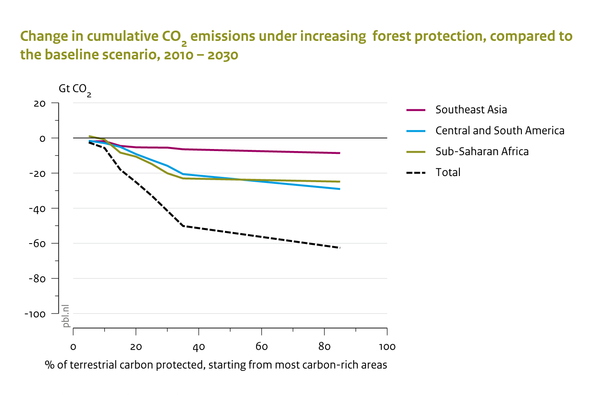Carbon cycle and natural vegetation/Policy issues
Parts of Carbon cycle and natural vegetation/Policy issues
| Component is implemented in: |
|
| Related IMAGE components |
| Models/Databases |
| Key publications |
| References |
Baseline developments
Several economic developments and policy interventions are related to the dynamics of the terrestrial carbon budget. The terrestrial and marine carbon budgets determine the overall reduction in greenhouse gas emissions and aerosols needed to limit CO2 build-up in the atmosphere. If the current terrestrial sink diminishes or becomes a carbon source, additional emission reductions will be required. Furthermore, protecting natural ecosystems or using alternative forest management options may contribute to storing and retaining more carbon in the biosphere (Doelman et al., 2019; Braakhekke et al., 2019). These options can be evaluated with the linked IMAGE-LPJmL model for baseline scenarios and policy interventions.
For instance, the IMAGE-LPJmL model has been used to assess key uncertainties about the terrestrial carbon balance (the figure below). The study conducted by Müller et al. (2016) included multiple values for climate sensitivity, including multiple climate patterns, for two different socio-economic scenarios. These experiments showed a possible shift in the terrestrial biosphere from sink to source under a broad range of changes in mean global temperature (2.3-6.8 °C up until 2100), and atmospheric CO2 concentrations (475–936 ppm). The rate of temperature increase was identified as the decisive threshold determining the shift, with values from 0.04 to 0.08 °C/y, depending on the GCM pattern. The LPJmL model calculations suggest that the likelihood of a carbon balance shift in the 21st century increases almost linearly from ~5% to ~90% when climate sensitivity is increased from 2.5°C to 5.0 °C.
Policy interventions
The model can also be used to study the impact of a range of policy measures, e.g. aimed at increasing the carbon storage of natural vegetation. Policy measures to increase carbon storage often generate co-benefits, such as restoration of watershed and wildlife habitats, and prevention of soil erosion. However, a critical issue is the permanency of additional carbon storage.
For instance, a policy intervention would be the use of forestry measures allowed under the Kyoto Protocol. The protocol provides opportunities for developed countries to partly achieve their emission reduction targets by planting new forests or by managing established forests and agricultural land to store more carbon in the soil (ARD), and to reduce emissions resulting from deforestation and degradation (REDD). IMAGE was used to estimate the emission reductions and costs related to REDD schemes (Overmars et al., 2014). Forest carbon stocks are protected expansion at increasingly high levels, and not available for agricultural use in MAGNET and IMAGE. As a result, agriculture expands less, and CO2 emissions are reduced by up to 100 Gt CO2 compared to baseline levels, with most of the reduction potential in Latin America and Africa (the figure below).
Effects of policy interventions on this component
| Policy intervention | Description | Effect |
|---|---|---|
| Afforestation policies | Increasing forest area to sequester CO2 in biomass which helps to achieve stringent climate targets. (Reference:: Doelman et al., 2020) | Reduces agricultural land use in regions with cost-optimal afforestation leading to higher food prices, lower food availability and changes in trade. |
| Expanding Reduced Impact Logging | Increasing the share of produced wood yielded with Reduced Impact Logging (RIL) practices instead of conventional logging practices. (Reference:: PBL, 2010) | RIL can change the volume of the C pools in the soil and vegetation pools and reduces the human induced land-use change emissions. |
| Increase forest plantations | Increase the use of wood from highly productive wood plantations instead of wood from (semi-) natural forests. (Reference:: PBL, 2010) | This intervention changes the regional C pools and fluxes. It limits the exploitation of (natural) forests and preserves the C budgets within these forests. In the plantations the C pools might become reduced. |
| More sustainable forest management | Sustainable forest management aims for maintaining long-term harvest potential and good ecological status of forests (e.g. the nutrient balance and biodiversity). This can be implemented by (i) enlarging the return period when a forest can be harvested again; (ii) only using certain fractions of the harvested biomass and leave the remaining part in the forests. | Sustainable forest management has an effect on the C storage in vegetation and soil of forests, and it enhances the net CO2 uptake by the forests (as degradation is avoided). |
| REDD policies | The objective of REDD policies it to reduce land-use related emissions by protecting existing forests in the world; The implementation of REDD includes also costs of policies. (Reference:: Overmars et al., 2012) | REDD measures can substantially reduce the pressure on forests. This increases the extent of natural forests, and the net CO2 uptake and C pools of forests. |


